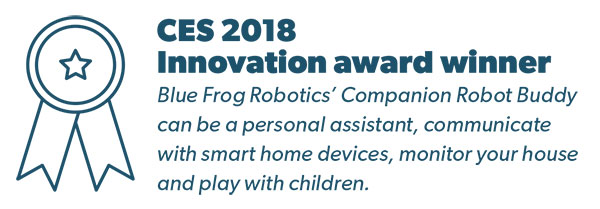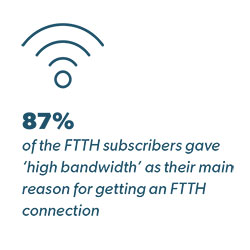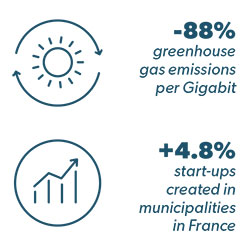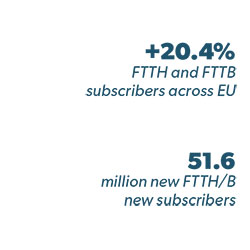The future is now
Tracking the future
The future is now
All the latest from the Las Vegas CES and FTTH Council Conference
New product introductions and research fi ndings presented at key industry events are an excellent indicator of wider trends and developments that have a marked eff ect on power and communications networks. For this edition of Insight, Prysmian visited two key events: The CES 2018, held in Las Vegas, and the FTTH Conference in Valencia. What new developments stood out – and how might they aff ect the ways in which we interact with energy and data networks?
MOBILITY
Chinese start-up Byton showed a car with a gigantic dashboard touchscreen using facial recognition to engage user-specifi c settings. Yamaha introduced a self-driving motorcycle and NUVIZ showed its motorcyclist Head-Up Display, incorporating navigation, cameras, infotainment and call management. Marked advances are being made in drone technology: Nuaviation’s Hyperlift 200E can carry objects weighing up to 200lb (91kg) at high speeds, which may open op new delivery possibilities in construction. The Whill Model Ci Personal Electric Vehicle allows people who have diffi culty walking to lead a more independent, connected lifestyle. In one of the show’s most futuristic moments, Surefl y presented its passenger octacopter. Connecting cars appears to be a popular topic, which can enhance road safety, but also allow vehicles to exchange info on free parking spaces. Drive IX and Xavier are introducing gesture control and facial recognition, native virtual assistants and natural language recognition into vehicles, opening the way for IoT applications.
Energy
There is a great deal of development at the crossroads of energy and digital services. Fairwind from Belgium constructed a scale model of its 100% recyclable small wind turbine that has a span of 11 - 15 metres and has been designed for use by farms and SMEs. Plug-and-play solar panels from Dutch start-up Supersola can be installed by anyone in fi fteen minutes. This type of small-scale energy generation requires a new approach to energy grids and (local) storage and exchange.
CES
The International Consumer Electronics Show (CES) is a major technology trade show in Las Vegas. The show has been held annually since 1967 and off ers product previews and product announcements. The show is sponsored by the Consumer Technology Association (CTA), a standards and trade organization for the US consumer electronics industry.
One thing seems to be clear from this year’s event: Smart Home, the Internet of Things (IoT) and electric and self-driving vehicles are taking off and the ‘next big thing’ may well be robots and AI. Of course, this introduces a range of new challenges when it comes to cabling to process all that data and keep a fast-growing range of devices powered.
Robotics and AI
CES featured a number of interesting robotics-related presentations. French company Navy explained its plans to deploy ‘robo-taxis’ worldwide. Honda presented its 3E Robotics range, which consists of several small robots, each designed with a specifi c function in mind.
LG also presented a family of function-oriented automated companions: a luggage-carrying hotel robot, a food service robot and a shopping cart robot. Blue Frog Robotics’ Companion Robot Buddy, winner of a CES 2018 Innovation award, can be a personal assistant, communicate with smart home devices, monitor your house and play with children. This innovation provides a personalized interaction hub. It is not inconceivable that compact service robots will lower the bar for bringing robots and AI into the home and workplace, heralding a much larger wave of adoption. Another example is ElliQ’s award-winning active aging companion, an AI-driven social robot designed for older adults, which proactively promotes an active and engaged lifestyle.
In the fi eld of Artifi cial Intelligence, the Intel® Movidius™ Neural Compute Stick stood out. The world’s fi rst USB-based deep learning inference kit and self-contained artifi cial intelligence accelerator delivers dedicated deep neural network processing capabilities to all kinds of host devices. Another CES award winner hinted at the possible computing power upcoming devices. AMD’s Ryzen Threadripper 1950X supports 16 cores and 32 threads, delivering world-class performance built around AMD’s powerful ‘Zen’ architecture.
Smart Homes
It would appear that advanced electronics in the home will become embedded to a degree that we’ll hardly notice they’re even there… Crownstone demonstrated a system in which a home’s lights and plug sockets react to the presence of individual’s smartphones and wearables, for example.

Award winner Wi-Charge’s long-range wireless power for mobile and IoT applications allow mobile and wireless devices to seamlessly recharge themselves without requiring any action on the part of the user. Wi-Charge product delivers safely wireless power across the room and mobile devices that are placed with-in range are charged.
This neatly solves one of the challenges related to developing the sensor network on which IoT applications are built. An increasing number of bandwidth-hungry 4K devices – and even an 8K TV – were on show, such as the compact LG 4K UHD home cinema projector.
Payments on the go
The award-winning Wallet Card™ from Dynamics Inc. is the fi rst payment card with a network (Visa/Mastercard) certifi ed core. All standard card information is presented on a display, and the card can present data from multiple card accounts. In this way, a hybrid is created between ‘traditional’ bank and credit cards and reliable, secure payment services previously associated with the online environment.
A prime example of how functionalities that were once fi xed to a physical location transferred to the internet and are reaching even higher levels of virtualisation.
FTTH COUNCIL CONFERENCE

This 2018 edition of the annual FTTH Council Conference was held in Valencia last February. The conference is organized by The FTTH Council Europe, an industry organisation with over 150 member companies, which aims to accelerate ubiquitous fibre-based connectivity throughout Europe. This year’s conference clearly demonstrated that fibre uptake is still on the increase, and that its widespread availability is essential in supporting of a wide range of technologies that bring vast potential benefits.
5G, IoT and self-driving cars: not without fibre
One recurring theme at the conference was the fact that many exciting new technologies won’t be able to deliver on their promise without fibre connectivity. Bandwidth-hungry innovations in areas such as 5G, Internet of Things, cloud services and application, smart buildings, Virtual Reality and Augmented Reality, fintech and autonomous traffic are all dependent on high-bandwidth, low-latency, always-on wireless infrastructure – and that, in turn, requires high-bandwidth, low-latency, ubuquitous wired backbone. This has to be scaled to suit wireless connection speeds.
But although 5G is a mobile technology, it requires optical fibre networks. Without ubiquitous fibre coverage, the effectiveness and potential of 5G networks and the applications that run on these will be severely limited. Ensuring technology harmonization and framework conditions and incentives are in place to support deployment of underlying network infrastructures is part of the solution.

The Socio-Economic Impact of FTTH
During the conference, results of research executed by WIK were shared. This study analysed the socio-economic benefits of FTTH in Sweden and The Netherlands.
The objective was to precisely understand the impact of fibre from the perspective of the end-users. 87% of the FTTH subscribers gave ‘high bandwidth’ as their main reason for getting an FTTH connection. One finding that particularly stood out is the fact that a vast majority of non-FTTH users want fibre. 94% of non-FTTH users indicated they would consider subscribing to FTTH if it was made available in their area.

In Europe, FTTH/B infrastructure is proven to have a positive impact on the environment with 88% less greenhouse gas emissions per Gigabit compared to other access technologies. There is also a correlation between economic growth an fibre: in France, for example, 4.8% more start-ups were created in municipalities equipped with ultrafast broadband compared municipalities with slower access.
In the USA, A 2017 study by RVA; LLC for the Fiber Broadband Association linked widely available all-fibre networks to new business formation, a better economy and more jobs.
Increasing uptake

During the event, the FTTH Market Panorama (prepared by IDATE for the FTTH Council Europe) was presented. This shows that the number of FTTH and FTTB (fibre to the building) subscribers across the EU 39 countries increased by 20.4% between September 2016 and September 2017. That’s 51.6 million new FTTH/B subscribers.
The take-up rate also soared to 34.8% from 29.9% the previous year. Russia added 1,826,000 new FTTH/B subscribers. Spain saw considerable growth with 1,612,371 new FTTH/B subscribers and France added 1,067,780 new subscribers. The number of homes passed (homes connected with FTTH/B) in the region grew significantly, reaching more than 148 million.
